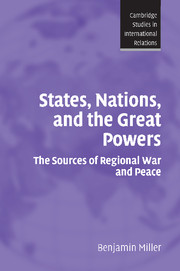Book contents
- Frontmatter
- Contents
- List of figures
- List of tables
- Preface and acknowledgments
- 1 Why some regions are peaceful and others are not
- 2 A theory of regional war and peace
- 3 States, nations, and war
- 4 Explaining the war proneness of the Middle East
- 5 The great powers war and peace in the Middle East
- 6 War and peace in the Balkans: states, nations, and great powers
- 7 The state-to-nation balance and the emergence of peace in South America during the twentieth century
- 8 The emergence of high-level peace in post-1945 Western Europe: nationalism, democracy, hegemony, and regional integration
- 9 Conclusions
- Appendix A Comparative dimensions of the state-to-nation imbalance in the Middle East, the Balkans, South America, and Western Europe in the post-1945 era
- Appendix B Data-file: major armed conflicts/wars by region, type, and modes of great power regional involvement (1945–2004)
- Bibliography
- Index
- Cambridge Studies in International Relations
5 - The great powers war and peace in the Middle East
Published online by Cambridge University Press: 22 September 2009
- Frontmatter
- Contents
- List of figures
- List of tables
- Preface and acknowledgments
- 1 Why some regions are peaceful and others are not
- 2 A theory of regional war and peace
- 3 States, nations, and war
- 4 Explaining the war proneness of the Middle East
- 5 The great powers war and peace in the Middle East
- 6 War and peace in the Balkans: states, nations, and great powers
- 7 The state-to-nation balance and the emergence of peace in South America during the twentieth century
- 8 The emergence of high-level peace in post-1945 Western Europe: nationalism, democracy, hegemony, and regional integration
- 9 Conclusions
- Appendix A Comparative dimensions of the state-to-nation imbalance in the Middle East, the Balkans, South America, and Western Europe in the post-1945 era
- Appendix B Data-file: major armed conflicts/wars by region, type, and modes of great power regional involvement (1945–2004)
- Bibliography
- Index
- Cambridge Studies in International Relations
Summary
The end of the Cold War affected various regional conflicts differently. Some dormant conflicts erupted violently, while others, violent during the Cold War, moved toward peaceful resolution. The contrast between the Middle East peace process and the eruption of war in the Balkans in the 1990s illustrates these trends. During the Cold War, the Middle East was one of the more volatile war zones in the world. In contrast, during the same period the Balkans, a region famed for its instability before the two world wars, was relatively stable and peaceful. In the 1990s, the character of both regions changed: an Arab–Israeli peace process was under way, even if haltingly, while conflict and war returned to the Balkans (see chapter 6).
Why? How does a zone of war become more peaceful while a zone of peace becomes volatile and combustible in such a short time? Does this variation testify to the limitations of the global system's influence on regional developments? If a global change such as the end of the Cold War leads to more violence in some regions and to less violence in others, is this evidence that indigenous regional/domestic factors, rather than systemic ones, determine regional events? Here, then, is the puzzle: Regional variations under post-Cold War unipolarity may suggest that the structure of the international system is indeterminate with regard to regional outcomes, which are influenced more by nonsystemic characteristics.
- Type
- Chapter
- Information
- States, Nations, and the Great PowersThe Sources of Regional War and Peace, pp. 205 - 255Publisher: Cambridge University PressPrint publication year: 2007

